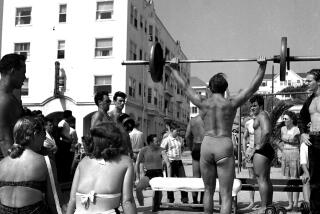Study Finds That Exercise Tends to Be for the Wealthy and the White
- Share via
WASHINGTON — Homemakers, blue-collar workers and members of minority groups share a similar approach to leisure-time exercise, a study finds--they’re less likely to do it.
In part, this may be because the typical recommendations for physical activity may be too male, too white and too wealthy to reach these groups, a researcher suspects.
“We must talk to people in a language they can understand,” said researcher Carlos J. Crespo of American University.
Crespo and his colleagues analyzed data on the physical activity habits of 18,825 adults who took part in the federal government’s third National Health and Nutrition Examination Survey, known as NHANES III.
Crespo’s research is a new take on two problems that bedevil exercise advocates. One is that participation in physical activity stubbornly refuses to rise. In the 1988-1994 NHANES III data, 23% of adults did absolutely no leisure-time physical activity. The other problem is that exercise is more common among well-off, well-educated white males.
In an analysis published in the journal Medicine and Science in Sports and Exercise, 47% of homemakers said they did no physical activity, compared with 40% of blue-collar workers and 29% of white-collar professionals.
Ranked by education, 47% of those who did not graduate high school were inactive, compared with just 26% of college graduates. By income, 47% of those earning less than $10,000 a year were inactive, compared with 32% of those earning $35,000 or more a year.
Part of the cause of these differences may be economic, Crespo said. “One of the hypotheses is that if you look at income, you are thinking of things you can do to improve your health,” he said. And it’s not just the ability to pay the dues at the health club.
For instance, men with money can hire people to do chores and free up more time to exercise, Crespo said. Poor people may think they have more pressing needs for their scarce money and may feel their neighborhoods are not safe enough for outdoor activities like walking, he said.
In addition, the poor and blue-collar workers may be more likely to have jobs that require physical exertion--whereas a high-powered executive might spend most of his workday at his desk.
However, a separate analysis of NHANES data, also by Crespo, indicates that ethnic status has its own relationship to exercise.
That study in the American Journal of Preventive Medicine found 40% of Mexican Americans did no physical activity in their time off, compared with 35% of blacks and 18% of whites.
The research says black and Mexican American men and women reported less activity than their white counterparts even when such points as income and education were held constant.
Cultural differences seem to play a part in this, although it’s hard to tell exactly how, Crespo said. It’s possible that blacks and Mexican Americans place less value on exercise than do white Americans, he said. But perhaps exercise simply has not been put into a cultural context that appeals to them, he said.
For instance, one common recommendation is brisk walking. But Hispanics and blacks may not be as ready to hear a message about walking as they would be about other forms of physical activity, Crespo said.
He recalled his own days growing up in Puerto Rico. “I was pushed to dance, and I liked it and you were rewarded for going to a dance party,” he said.
And nonwhites may not see the experts’ health messages as directed particularly at them, Crespo said. He cited one case in which a sign in a mall suggested people climb stairs instead of taking the elevator. “It worked, but it didn’t work for black women,” he said. When a picture of a black person was added to the sign, more black women took the stairs, he said.
While the government encourages exercise as a way to better health, health clubs want to encourage exercise as a way to increase profits. However, the health club is still largely a domain of those with more money, said Bill Howland, research director for IHRSA, the International Health, Racquet and Sportsclub Assn.
IHRSA’s latest membership information shows almost 38% of members have household income of $75,000 or more, compared with 14% of those earning less than $25,000. Clubs are trying to find a way to get more members from the under-$75,000 set, Howland said.
The owner of one for-profit health club chain, however, sees potential for clubs in the inner city. Laury Hammel of the Longfellow Clubs in Massachusetts is taking on the development of the nonprofit Sportsmen’s Tennis Club in Boston’s Dorchester section into a full-service health club.
“We are trying to reach the inner-city population that cannot afford the typical for-profit clubs,” Hammel said. The new club could keep membership fees low by keeping its own costs low, he said. Equipment is being donated, and the club does fund-raising.
Poor people who work long hours at low wages don’t have much time or money to exercise, Hammel noted. But it won’t take many users to make the club a success, he said. A lot of people live in the Dorchester area, and even if 5% to 10% show up, “it will be packed.”






